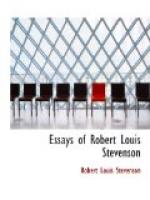NOTES
During the year 1888, part of which was spent by Stevenson at Saranac Lake in the Adirondacks he published one article every month in Scribner’s Magazine. Pulvis et Umbra appeared in the April number, and was later included in the volume Across the Plains (1892). He wrote this particular essay with intense feeling. Writing to Sidney Colvin in December 1887, he said, “I get along with my papers for Scribner not fast, nor so far specially well; only this last, the fourth one.... I do believe is pulled off after a fashion. It is a mere sermon: ... but it is true, and I find it touching and beneficial, to me at least; and I think there is some fine writing in it, some very apt and pregnant phrases. Pulvis et Umbra, I call it; I might have called it a Darwinian Sermon, if I had wanted. Its sentiments, although parsonic, will not offend even you, I believe.” (Letters, II, 100.) Writing to Miss Adelaide Boodle in April 1888, he said, “I wrote a paper the other day—Pulvis et Umbra;—I wrote it with great feeling and conviction: to me it seemed bracing and healthful, it is in such a world (so seen by me), that I am very glad to fight out my battle, and see some fine sunsets, and hear some excellent jests between whiles round the camp fire. But I find that to some people this vision of mine is a nightmare, and extinguishes all ground of faith in God or pleasure in man. Truth I think not so much of; for I do not know it. And I could wish in my heart that I had not published this paper, if it troubles folk too much: all have not the same digestion nor the same sight of things.... Well, I cannot take back what I have said; but yet I may add this. If my view be everything but the nonsense that it may be—to me it seems self-evident and blinding truth—surely of all things it makes this world holier. There is nothing in it but the moral side—but the great battle and the breathing times with their refreshments. I see no more and no less. And if you look again, it is not ugly, and it is filled with promise.” (Letters, II, 123.) The words Pulvis et Umbra mean literally “dust and shadow”: the phrase, however, is quoted from Horace “pulvis et umbra sumus”—we are dust and ashes. It forms the text of one of Stevenson’s familiar discourses on Death, like Aes Triplex.
[Note 1: Find them change with every climate, etc. For some striking illustrations of this, see Sudermann’s drama, Die Ehre (Honour).]
[Note 2: NH3 and H2O. The first is the chemical formula for ammonia: the second, for water.]
[Note 3: That way madness lies. King Lear, III, 4, 21.]
[Note 4: A pediculous malady ... locomotory. Stevenson was fond of strange words. “Pediculous” means covered with lice, lousy.]
[Note 5: The heart of his mystery. Hamlet, Act III, Sc. 2, “you would pluck out the heart of my mystery.” Mystery here means “secret,” as in I. Cor. XIII, “Behold, I tell you a mystery.”]




